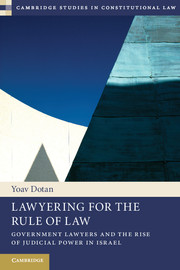Book contents
- Frontmatter
- Dedication
- Contents
- Acknowledgments
- List of figures
- List of tables
- Introduction The government’s lawyer
- 1 The Israeli legal system and the rise of judicial activism in the High Court of Justice
- 2 The High Court of Justice Department (HCJD): overview and history
- 3 Litigating for the government
- 4 The dilemma of serving two masters
- 5 Sorting things out: government lawyers in transformative litigation
- 6 The government lawyer as adjudicator: “pre-petitions” and the HCJD
- Conclusion
- Table of Cases
- Bibliography
- Index
3 - Litigating for the government
Published online by Cambridge University Press: 05 June 2014
- Frontmatter
- Dedication
- Contents
- Acknowledgments
- List of figures
- List of tables
- Introduction The government’s lawyer
- 1 The Israeli legal system and the rise of judicial activism in the High Court of Justice
- 2 The High Court of Justice Department (HCJD): overview and history
- 3 Litigating for the government
- 4 The dilemma of serving two masters
- 5 Sorting things out: government lawyers in transformative litigation
- 6 The government lawyer as adjudicator: “pre-petitions” and the HCJD
- Conclusion
- Table of Cases
- Bibliography
- Index
Summary
In the previous chapters I described the rise of judicial activism in Israel during the 1980s, as well as the shift in the HCJD’s professional ideology during the same period. I argued that during this period the HCJD abandoned the traditional model of lawyering for the government (a model that prevailed until the late 1970s) and adopted a new one, which I called the “rule of law lawyering” model. Under this model, the HCJD regards itself as not merely the representative of its agencies in court, but rather as a supervisory organ that seeks to promote the general values of the rule of law in the government, values that are manifested by the institution of the HCJ itself. Thus, the HCJD was transformed from an organ whose main objective is to represent the government in court into a supervisory organ that is primarily accountable to the HCJ and serves as its extension or, at least, views its accountability towards the court on the institutional and ideological level as no less important than its professional duty towards its client agencies. In this chapter I deal with the implications of this transformation on the main function of the HCJD, that is on patterns of litigation in the HCJ.
Methodological background
In order to test the shift in patterns of litigation during the 1980s, I conducted a quantitative analysis on two groups of HCJ cases – those from the 1970s and the 1990s. This was done since the process of the rise of judicial activism at the HCJ and the shift in the HCJD began in the early 1980s and was completed, to a large extent, towards the end of that decade. Therefore, the impact of the process should be well reflected in a representative sample of cases disposed of by the HCJ before and after that shift. This longitudinal analysis was complemented by comparing two groups of cases disposed of during the 1990s: petitions issued to the HCJ against the central government of Israel, and petitions issued during the same period against local municipalities.
- Type
- Chapter
- Information
- Lawyering for the Rule of LawGovernment Lawyers and the Rise of Judicial Power in Israel, pp. 87 - 118Publisher: Cambridge University PressPrint publication year: 2013

